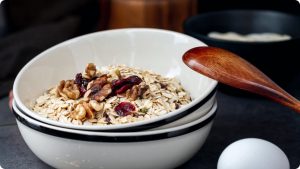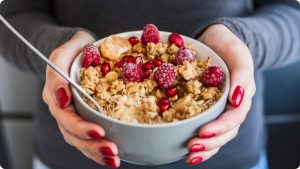Did you know that in 2021, the US was the number one in breakfast cereal sales, with retail sales of around 7,000 million dollars? Germany was sixth on the list, with 1,243 million dollars of cereal retail sales. Many of us love our cereal. Cereals are convenient, tasty, and varied and can be consumed at any time of the day to cheer us up. In addition, many people associate certain cereals with their childhoods, so nostalgia can play a role in our cereal choices.
But as we become more health-conscious, many people wonder whether they can still enjoy cereals. Or are all of the “healthy” and “natural” cereals on the market simply good marketing?
In this post, we’ll cover the top 10 healthy cereals that make a great breakfast.
What to look for in a healthy cereal
Are cereals healthy? If you look at the most popular cereals, you’ll likely find those full of sugar, refined grains or other things that you may want to eat less of. However, breakfast cereals aren’t necessarily bad. In fact, there’s been an increase in healthier cereal types and a general trend for making cereals healthier than they once were.
Breakfast cereals can be nutritionally dense, providing plenty of important vitamins, minerals, antioxidants, and whole grains. This is especially true for healthier fortified cereals, which can be an important source of vitamins and minerals for populations that cannot get enough micronutrients without fortification.
A systematic review has found that breakfast cereal consumption tends to be associated with a more nutritious diet. Oat, barley, and psyllium-based cereals can support healthy blood fat levels, while cereals with a high fiber content can support gut health. Other claims of cereal benefits exist, but they currently have insufficient evidence.
It’s important to note, though, that many studies in this area will ultimately have been commissioned by those who have something to gain from positive studies. Nevertheless, you can enjoy cereals as part of a healthy diet.
When you’re picking a cereal to eat, look out for the following:
- Plenty of fiber, striving for more than 3 grams
- Lower levels of saturated fats, aiming for under 3 grams of total fat
- Lower sugar levels, with under 6 grams being best
- Wholegrain cereals rather than processed ones
- A higher protein content compared to other cereals
Don’t forget that what a cereal is made from is not the only thing that affects its nutrition. What you pair cereal with is equally as important. To make your cereals more nutritious, consider toppings or milk alternatives to enhance the cereal’s nutritional profile.
For example, if you want to increase your fiber intake, top off your cereal bowl with fruit and nuts.
Fruit fiber is a potent health booster. Consumption of whole fruits is associated with better gut health, weight management, and a lower risk of heart disease and other pathologies. Stick with fresh or frozen fruits instead of dried fruits to limit your sugar intake. It’s an easy way to get one of your five a day while also enjoying a breakfast you love.
Nuts are another great addition to cereals; you may find them added to things like muesli. Nuts are a powerhouse of nutrients, containing plenty of fiber, some protein and healthy fats to keep you full. In addition, nuts are rich in beneficial antioxidants, vitamins and minerals.
For those who want to increase their protein intake, why not use a protein-rich base for their cereal? Milk is always a good choice—100 grams of milk provides just over 3 grams of protein. If you’re eating a cereal higher in protein, you may find that milk is enough.
But there are other things that you can eat your cereal with to boost protein levels. For example, cereal and Greek yoghurt can be a great combination. 100 grams of plain Greek yoghurt can provide around 10 grams of protein. That can be a game changer for those who find themselves hungry after cereal for breakfast, as protein boosts satiety.
In addition, yoghurt is an excellent medium for protein powder, which can take your cereal breakfast to a high-protein breakfast of champions. Adding a 100% Golden Whey scoop can boost your cereal’s protein content by 24 grams!
Looking for inspiration? Try our recipe for a Granola Yoghurt Pot!
Don’t forget that if you have the time and ability to do so, you can make your DIY healthy cereal. For example, the benefit of making your own granola is that you’re in charge of the ingredients. You can use whole grains, high-fiber oats, and plenty of nuts to control your sugar levels. What’s not to love about the healthiest cereals to eat that are also packed with love?
10 Healthiest and Taste-Great Cereals:
Ready to jump onto the world of the best healthy cereals that make a great breakfast, snack or dinner for the most adventurous ones? Let’s look at the top healthiest cereals that taste awesome.
Oats
While some people may not consider oats a type of cereal, it’s still important to mention. Oats are a true treasure of nutrients. This cereal contains plenty of carbohydrates, proteins, dietary fibres like beta-glucan, important phenolic compounds and plenty of antioxidants.
In addition, it contains micronutrients like vitamin E, folate, zinc, selenium, copper, iron, manganese, choline, and beta-carotene.
Oats have been found beneficial in the following ways:
- They may help us manage lipid levels in the blood, such as our cholesterol levels
- They may help us control blood sugar levels and tend to be lower on the glycemic index
- They may help us feel full and control our appetite, which helps manage body weight and fat levels
- Oats may support gut health
- They may even have immunomodulatory properties, which can be beneficial for our natural defences
- They may have antioxidant activity and anti-inflammatory activity
If you’re looking to incorporate oats into your routine, pay attention to how much processing your oats have had. Processing can affect how quickly oats raise your blood sugars or their glycemic level. Groats, steel-cut and Scottish oats tend to undergo less processing compared to rolled or instant oats.
In addition, oats make a splendid granola base if you’re making your own.
Granola
Granola is another good choice for those trying to make healthier breakfasts. It is usually made of oats, nuts, some sweeteners like honey, grains, seeds, or dried fruit.
Granola can be a filling option, as it contains plenty of fiber and protein. These two components help us stay full for longer. In addition, nuts and seeds in granola can provide plenty of fats, protein, and micronutrients.
A small study shows that granolas high in beta-glucan may help with satiety and support healthier blood profiles and microbiome function.
Granola is a popular health cereal. However, it’s a good idea to check the sugar and fat levels in your granola. It’s even better if you can make granola at home, as that way, you can easily control the sugar and fat levels.
Sprouted Grain Cereals
Sprouted grains have generated increased interest recently as people are looking for healthier foods. Their specific definition requires that the original bran, germ, and endosperm be retained and that the sprouting process do not affect nutritional qualities.
Sprouted seeds have been around for a while, and Eastern countries traditionally consume them. Sprouting grains can increase macro and micronutrient content and improve their nutritional profiles. Sprouting increases simple sugar content but preserves resistant starch. Sprouting can increase fiber content and amino acid content, supporting nutrition.
These types of cereals can be a good choice for those who would like to avoid large amounts of sugar. In addition, manufacturers of the Ezekiel sprouted cereals claim that they have plenty of dietary fiber and protein, which is an excellent addition to anyone’s diet.
Organic Cereals
Organic cereals may not be the first thing you think about when considering what the healthiest breakfast cereals are. Organic foods are popular with some people, including organic cereals.
Organic foods tend to be produced without chemical fertilizers, pesticides, hormones, GM or antibiotics. There’s some controversy around the nutritional qualities of organic vs conventional foods, so how do organic cereals measure up?
A comparison suggested no nutritional differences between organic and conventional cereals. Therefore, as with other cereals, pick organic cereals with plenty of fiber, protein, little sugars, and added fats.
Wheat Cereal
Wheat cereals are very popular with people across countries. Wheaties and shredded wheat are good examples of wheat cereals.
Wholegrain wheat cereals can be beneficial for our gut bacteria and have a prebiotic effect. Whole grains are essential in providing us with carbohydrates for energy. In addition, they provide carbohydrates that we cannot digest and that are associated with better general health. Wheat is also a good source of iron and zinc.
Check out this blog post if you’re curious about supporting your gut health with probiotics or learning what prebiotics are.
In addition to whole wheat cereals, you can have wheat bran cereals. The bran is the part of the wheat kernel that is typically taken away during milling. Wheat bran has the most antioxidant phytochemicals out of the whole wheat kernel, which has beneficial effects on health.
Wheat cereals, especially bran cereals, can be a good option for a healthy breakfast. For the healthiest bran cereals, choose those with little added sugar and plenty of fiber.
Spelt Flakes
Spelt is a type of wheat that used to be grown in Northern Europe but has now declined in popularity. Spelt wheat may have slightly higher phenolic concentrations and antioxidants than typically used wheat. In addition, it may be somewhat higher in protein and mineral micronutrients. This can make spelt cereals an excellent option for a healthy breakfast cereal.
Chia cereal
Chia has taken the world of social media breakfasts by storm. Whether you add it to your cereal, buy cereal with chia or even eat it in muesli form, chia is a great source of nutrients.
Chia contains the following nutrients:
- Protein – chia can be high in protein
- Dietary fiber – chia is a good source of fiber for gut health
- Fats – chia are a great source of omega-3 fatty acids, which are beneficial for our brain, skin and eyes
- Antioxidants and phenolic compounds that support well-being and health
The addition of chia to cereal can take your breakfast from tasty to extra healthy.
High Protein Muesli
Protein can make breakfast more satiating, making it an excellent option for many. Whether you’re on a weight-loss journey, growing muscle, or simply wanting to feel less hungry, high-protein muesli can be for you. The combination of fiber from oats and grains and the protein can keep you satiated for longer.
Muesli No Added Sugar
Another type of muesli that will strike a chord with the health-conscious is the no-added sugar muesli. They may contain dried fruit to add sweetness, but this is a wonderful option for those trying to watch their sugar intake.
Multigrain cereal
Multigrain cereals can be a solid breakfast choice. Containing multiple types of cereals, you’ll get different nutrients from each. Choose high-quality wholegrain multigrain cereals and look out for large amounts of sugar. Whole grain versions of multigrain cereals will tend to offer more fiber, supporting gut health and keeping you full.
You may be trying to make easy breakfasts or would simply like to switch your favorite cereal treat for a healthier option. You can indeed find healthier cereal options that will keep you satiated and provide plenty of fiber for your gut health. After all, there’s nothing better than starting the day with good food and a good mood.









